Planning to take on Iceland’s famous Ring Road? Whether you’re heading over during summer’s endless light or arriving in the middle of winter chasing the Northern Lights, this guide is here to help you make the most of every minute.
We know it can be tricky deciding where to go and how to fit it all in, especially when every single place seems like it belongs in a fantasy film or your next screensaver, and with the amount of content and social media posts, it can be a little overwhelming to set up the right journey.
That’s exactly why we’ve created this 7-day Ring Road itinerary. It’s built to work no matter the season, balancing bucket-list spots with local favourites and enough breathing room to pull over when something unexpected catches your eye. Which, in Iceland, happens a lot – mountains, glaciers, volcanoes…sheep, and Icelandic horses?! You get the point.
This isn’t just for experienced road-trippers or those with colour-coded travel spreadsheets. Whether you’re flying in with a full plan or just a sense of curiosity, we’ve got you covered. Read on to find out where to stop, what to skip, and how to turn a simple road trip into an unforgettable Icelandic adventure.
Iceland’s Ring Road

Also known as Route 1, Iceland’s Ring Road circles the entire island. It covers around 1330 kilometres (826 miles…not entirely sure how many yards). It passes through nearly every type of landscape the country has to offer, including thundering waterfalls, black sand beaches, lava fields, sleepy fishing villages, steamy geothermal hot spots, and jaw-dropping fjords. It’s like someone AI-generated together all the best bits of a fantasy film and gave it wheels.
The Ring Road is mostly paved and well-maintained, making it accessible to all types of campervans during the summer months. In winter, things can get a bit more challenging (read: snowy) at times, so always check road conditions before setting off.
It’s also worth noting that while the Ring Road is efficient, some of Iceland’s best detours are just off it. With your campervan, you’ve got the flexibility to explore those tempting turnoffs which we’ll guide you through below.
Ready to tackle it in seven days? We’d normally recommend more time to enjoy more stops, but we know that’s not always an option.
Day 1: Reykjavík to the Golden Circle
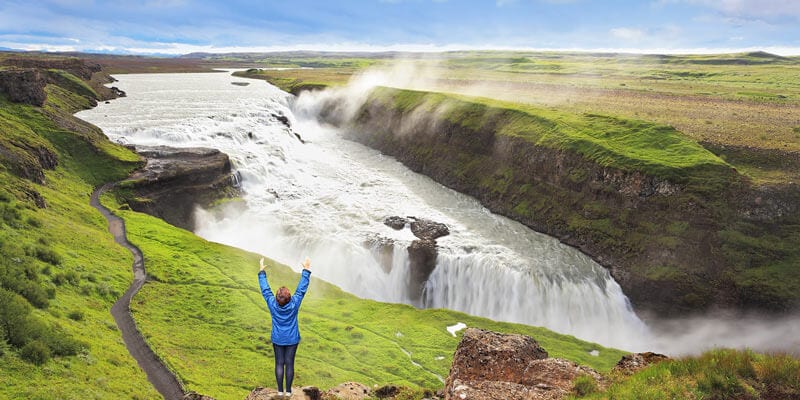
Start your journey off by visiting Iceland’s most famous tourist trail (and for good reason), where the tectonic plates of Eurasia and North America visibly split – the Golden Circle. Not to overdo it, but this is one hell of a start to adventure by immediately journeying to where the earth literally splits apart in front of you, steams from its pores, and thunders its way through canyons like it’s narrating the opening scene of a Viking saga.
From Reykjavík, you’ll head inland to the legendary Golden Circle, a trifecta of geothermal wonder, geological awe, and sheer natural power. This region sets the tone for the entire trip, reminding you immediately that Iceland doesn’t do subtle. This includes the boiling geyser of Strokkur that shoots hot geothermal steam up to 20m high around every 5-10 minutes, tectonic plates pulling apart like they’re on bad terms, and a waterfall so mighty you half expect to see Thor (and maybe one or two of the other Avengers) himself riding the spray into battle. This is Iceland turning the volume up to eleven from the very start.
Our Recommended Attractions & Activities
Kick things off at Þingvellir National Park, a UNESCO World Heritage Site where the Eurasian and North American tectonic plates are pulling apart. It’s also where Iceland’s first parliament was formed (Alþingi), so it’s kind of a big deal. Walking directly through the fault line, you’ll even have the opportunity to take a diving tour directly between the tectonic plates on your visit in the crystal clear waters of Silfra for the ultimate snorkelling bucket list treat.
Next up is Geysir, the original geyser, which gave its name to all others. While Geysir itself is now more of a sleepy elder statesman, nearby Strokkur erupts every five to ten minutes. Stand back unless you fancy a surprise shower.
Finish your Golden Circle loop at Gullfoss, a waterfall so huge and cascading down the Hvíta river canyon over two steps, which regularly produces one of the most surreal rainbows you’ll ever see.
Recommended Local Campsites
Set up for the night at Skjól Campground or Laugarvatn Campsite. Both are well-located and offer access to warm showers and even warmer geothermal baths.
Day 2: Golden Circle to Iceland South Coast Wonders
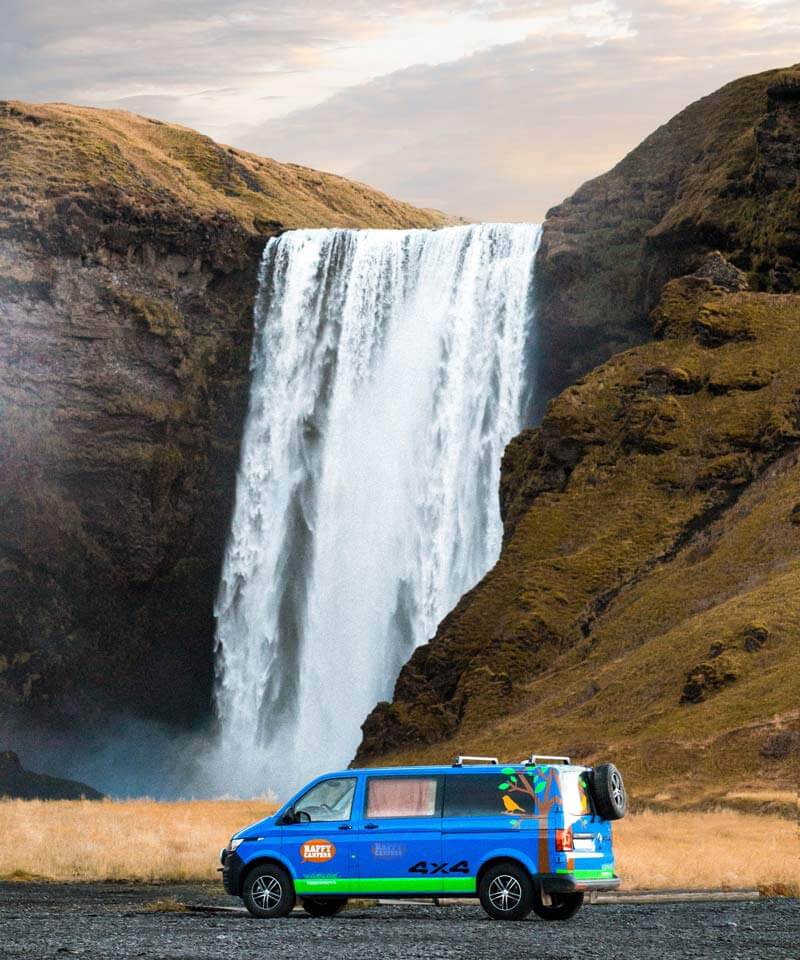
Now that you’ve cracked open Iceland’s treasure chest of volcanic wonder and geothermal chaos, it’s time to buckle up and follow Route 1 as it snakes south into a land that inspires with an array of otherworldly wild terrain.
This stretch of the journey throws subtlety out the window. Here, nature shows off with towering waterfalls you can walk behind, glaciers that look like they belong on another planet, and beaches where the sand is blacker than your coffee after a night of aurora chasing.
The landscape changes every ten minutes, from lava fields to lush cliffs, and with each curve in the road, Iceland just keeps turning up the drama like it’s constantly auditioning for the National Geographic photographer of the year award. If the Golden Circle was the warm-up act, the South Coast is where the headline performance really begins.
Our Recommended Attractions & Activities
First, stop at Seljalandsfoss, the waterfall you can walk behind (prepare to get wet, but it’s worth it). Then it’s on to Skógafoss, one of Iceland’s most powerful falls and home to more rainbow selfies than you can shake a tripod at. It’s also home to the intriguing folklore of great treasure claimed to be hidden behind its falls – see if you can glimpse it.
While in Skógar, be sure to check out the lesser-known cousin waterfall of Kvernufoss. At only a short 15-minute hike from its more famous sibling, alike Seljalandsfoss, this waterfall also offers the opportunity to walk behind the falls, but with a fraction of the footfall.
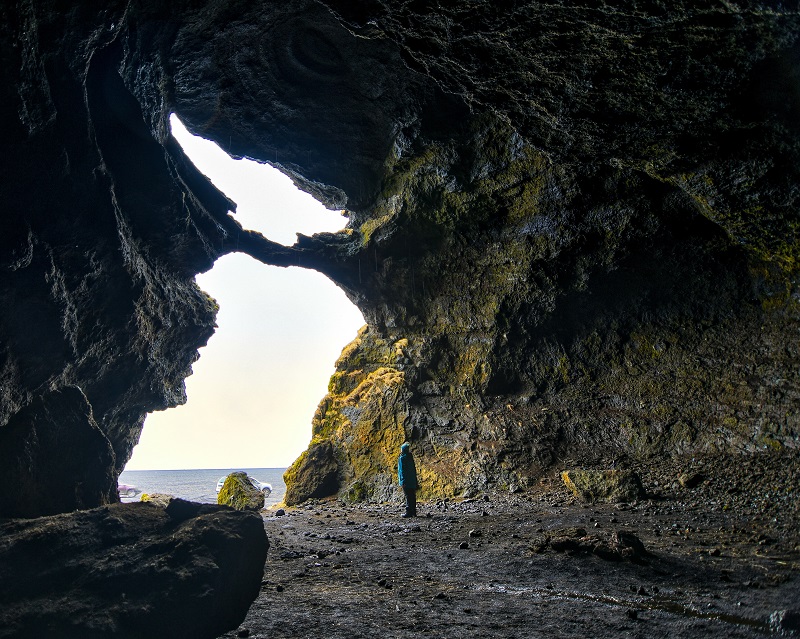
Not far from there is the Sólheimajökull glacier, where you can join a guided glacier hike if you want to get up close and icy. Cap off the day at Reynisfjara Black Sand Beach near Vík, famous for its basalt columns and waves that will absolutely test your reflexes.
And, if you’re planning on a summer visit, be sure to take a slight detour to check out the famous Yoda cave at the end of an older, rugged road. If you’re visiting on May 4th, please go easy on the cringe…or go nuts!
Recommended Local Campsites
Camp in Vík, where the campsite has excellent views and decent facilities. If you’re chasing a more peaceful spot, Hamragarðar campsite near Seljalandsfoss is also a great option.
Day 3: Vík to Jökulsárlón Glacier Lagoon
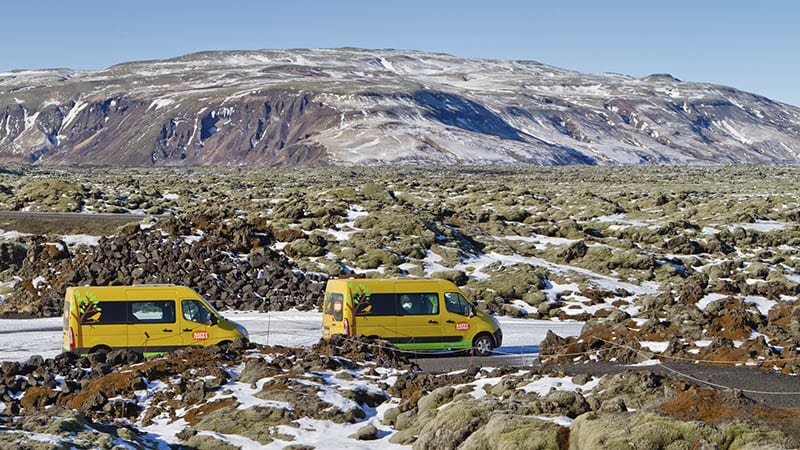
The third day is all about diving into Iceland’s ever-shifting scenery, where no two landscapes look alike, and you start to immerse yourself more and more into glacier country. You’ll start the day cruising past ancient cliffs that tower dramatically over the coastline like stone giants keeping watch.
Then, without warning, the terrain flattens out into stark black sand plains followed by endless lava fields produced from the great fires of the famous Laki eruptions, which some claim were a major cause of the French Revolution.
And just when you think Iceland couldn’t possibly top itself, you’ll find yourself standing at the edge of a glacial lagoon, watching icebergs the size of small houses drift lazily past curious seals, with some washed up across the road on the famous Diamond Beach.
It’s a visual rollercoaster where textures change by the kilometre, and every new view begs for a camera click, or at least a long, quiet stare – to each is their own.
Our Recommended Attractions & Activities
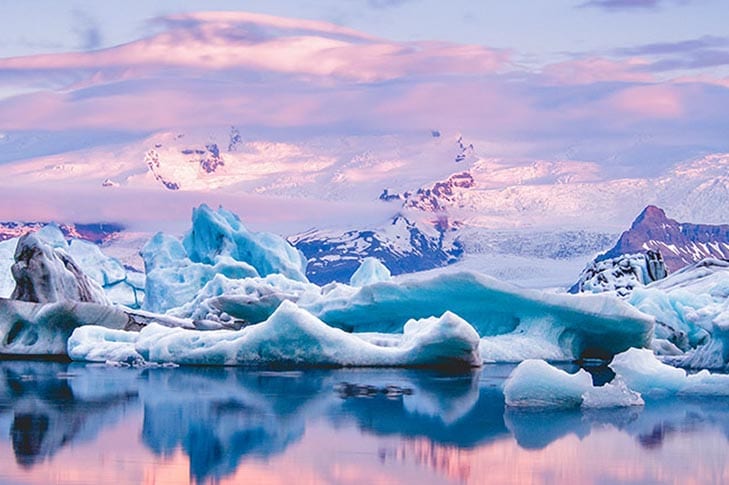
Drive through lava fields and coastal plains until you reach Skaftafell in Vatnajökull National Park. Here, you can take short hikes to glaciers or longer treks to panoramic viewpoints. Don’t miss the walk to Svartifoss, a waterfall framed by black basalt columns that look suspiciously like a giant’s organ pipes – you’ll quickly be able to see how the architect of Hallgrimskirkja church in Reykjavík captured his inspiration.
Then it’s on to the star of the show: Jökulsárlón Glacier Lagoon. Watch as chunks of ice drift lazily out to sea. Across the road, the Diamond Beach is where they wash up like glittering leftovers from Elsa’s tantrum. Be careful not to sit on the icebergs here as the strong currents can quickly (and have done) take you out to sea.
Recommended Local Campsites
Stay at the Höfn campsite or at Skaftafell Campground within the national park. Both offer excellent base camps for exploring the surrounding area.
Day 4: Jökulsárlón to Iceland’s Stunning Eastfjords
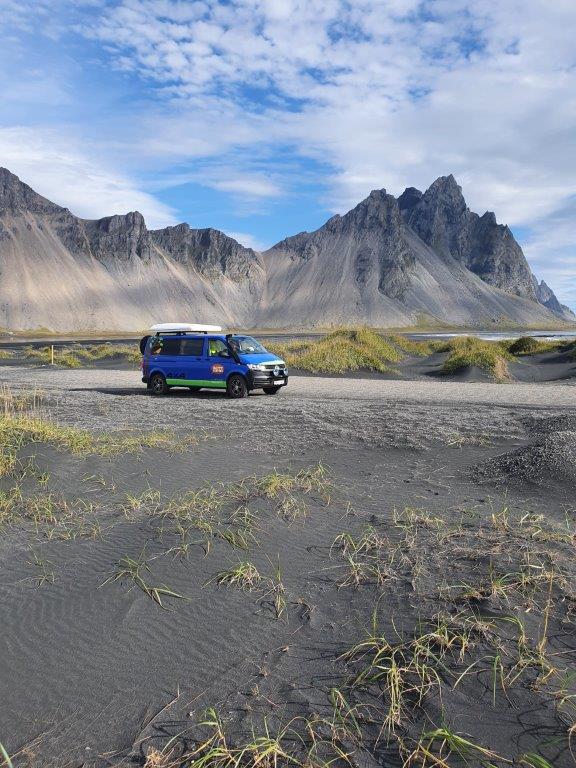
Welcome to the wild east. This is where Iceland dials down the drama just a notch and replaces it with serene beauty, peaceful isolation, and landscapes that feel like they were handcrafted for slow mornings and even slower road trips.
The Eastfjords of Iceland are full of winding coastal roads that hug the mountains with just enough space for one very epic campervan, tiny fishing villages that look like they haven’t changed in a century, and fjords so still they reflect the sky like a mirror.
It’s the kind of place where time seems to stretch out, and your phone magically becomes less interesting than the shapes of clouds. This is Iceland unplugged and the perfect place for quiet hikes, wildlife spotting, or simply brewing a cup of coffee while staring into a fog-covered fjord wondering why you didn’t come here sooner.
Our Recommended Attractions & Activities
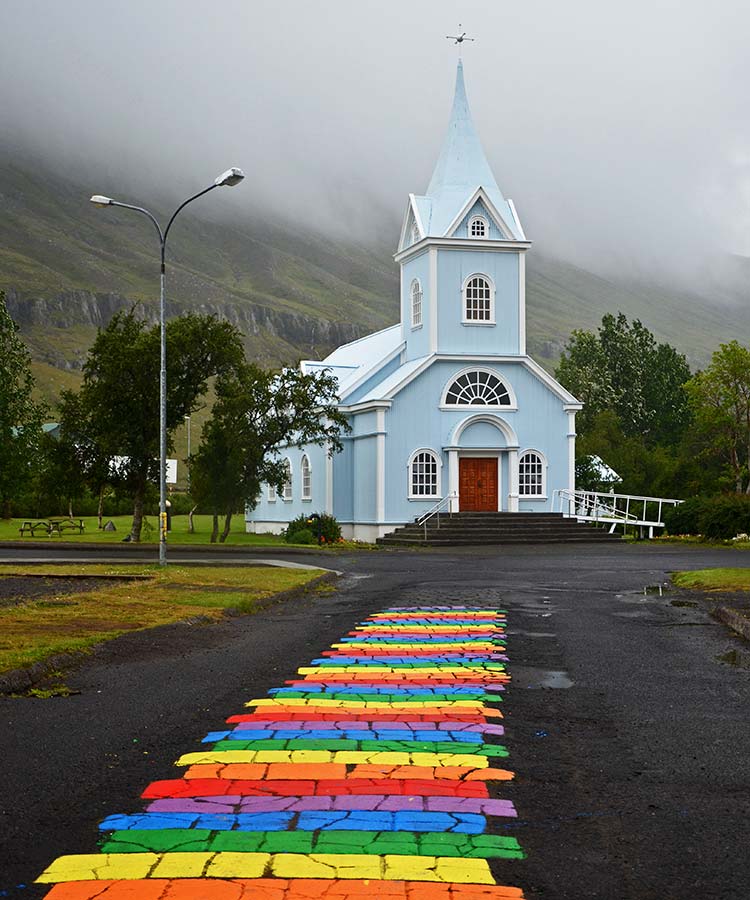
Start early and cruise through scenic mountain roads. Stop at Djúpivogur for coffee with a view. Then wind your way through the Eastfjords where you might spot reindeer roaming and puffins posing like influencers (we highly recommend Borgarfjörður Eystri for the latter).
Try a short hike around Petra’s Stone Collection in Stöðvarfjörður or just soak in the silence.
If the road conditions allow it (summer is fine), make sure you at least take a short journey over the stunning mountain pass to Seyðisfjörður (the road down into the town is where they filmed the skateboard scene in The Secret Life of Walter Mitty).
Recommended Local Campsites
Egilsstaðir Campsite is a popular and well-equipped option. Seyðisfjörður also has a colourful little site tucked into one of the prettiest fjords in Iceland – you’ll definitely want to walk down the rainbow road Seyðisfjarðarkirkja, in amidst the surrounding towering mountains that carve this stunning fjord.
Day 5: Icelandic Eastfjords to Lake Mývatn

Time to leave the coast behind and head into a different kind of Icelandic drama – the kind that bubbles, steams, and occasionally smells like eggs (ok, quite often).
Today, you’re making your way into the North’s geothermal playground, where the Earth never quite sits still and the scenery looks like the backdrop of a very stylish sci-fi film – Prometheus and Game of Thrones back up my point here.
Volcanoes slumber beneath your wheels, hot springs steam from the ground, and the terrain flips between lava fields, craters, and strange mud pools that burp ominously, particularly at Námaskarð.
It’s one of the most geologically active regions not just in Iceland, but in the world. Every viewpoint feels like you’ve stumbled onto another planet, and the smells, colours, and textures are completely unforgettable. Buckle up for a day of sensory overload in the best possible way.
Our Recommended Attractions & Activities
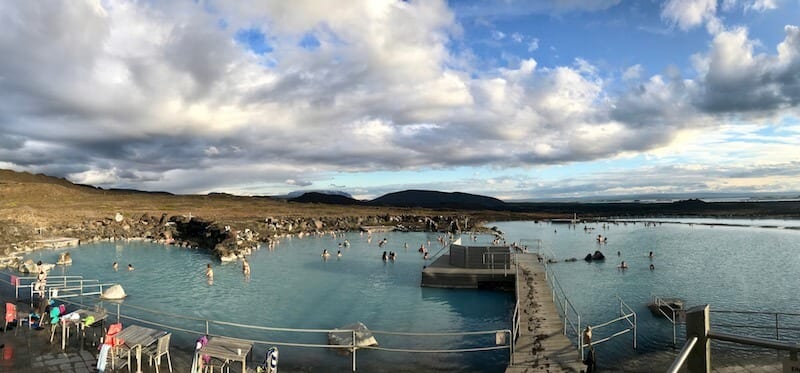
Drive past Herðubreið (aka Queen of the Mountains) and make your way to the Lake Mývatn area. Explore the otherworldly landscapes at Námaskarð, take a dip in the Mývatn Nature Baths (like the Blue Lagoon, but less crowded), and walk around the lava formations at Dimmuborgir.
Dettifoss, Europe’s most powerful waterfall, is also a short drive away and worth the detour if roads allow. You can visit on both the east and west side of the falls – the west is often more accessible due to the better maintained roads and car park.
Recommended Local Campsites
Reykjahlíð campsite by Lake Mývatn is a favourite among Happy Campers travellers. It’s got all the essentials plus killer views.
Day 6: Mývatn to Akureyri

After five days of wild landscapes and rugged coastlines, today offers a change of pace – a chance to ease back into civilisation without losing that jaw-dropping scenery. You’ll swap dramatic lava fields and windswept cliffs for café-lined streets, quirky museums, and a scenic harbourfront all tucked into a postcard-perfect fjord.
Welcome to Akureyri, the unofficial capital of the North, where Icelandic city life means charming bookshops, street art with a sense of humour, and swimming pools heated by geothermal hot springs with views to rival any spa – it also hosts the stunning Forest Lagoon which is well worth a dip if you have time.
It’s a chance to stock up on supplies, stretch your legs in the city, and soak in a bit of local culture while still feeling like you’re on the edge of the Arctic Circle.
Whether you spend the day whale watching in Húsavík, admiring the architecture of Akureyri Church, or just sipping coffee as the mountains reflect off the fjord, this stop offers the perfect urban reset before you dive back into Iceland’s wilderness tomorrow.
Our Recommended Attractions & Activities
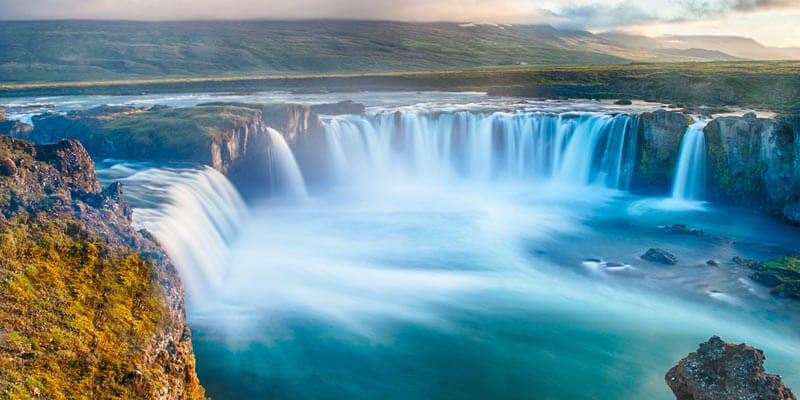
Stop at Goðafoss waterfall en route, then arrive in Akureyri, Iceland’s second-largest city. It’s still charmingly small but full of character. Visit the botanical gardens, stroll the waterfront, or grab a coffee downtown – if you’re arriving before midda, I’d highly recommend Cafe Berlin for a hearty brunch.
If you’ve got time and the whales are calling, Húsavík is just a detour away and offers some of the best whale watching in the world.
Recommended Local Campsites
Hamrar Campsite in Akureyri is a clean and quiet spot with hiking trails nearby. If you’re up for something more remote, head back out toward Húsavík.
Day 7: Return to Reykjavík via West Iceland
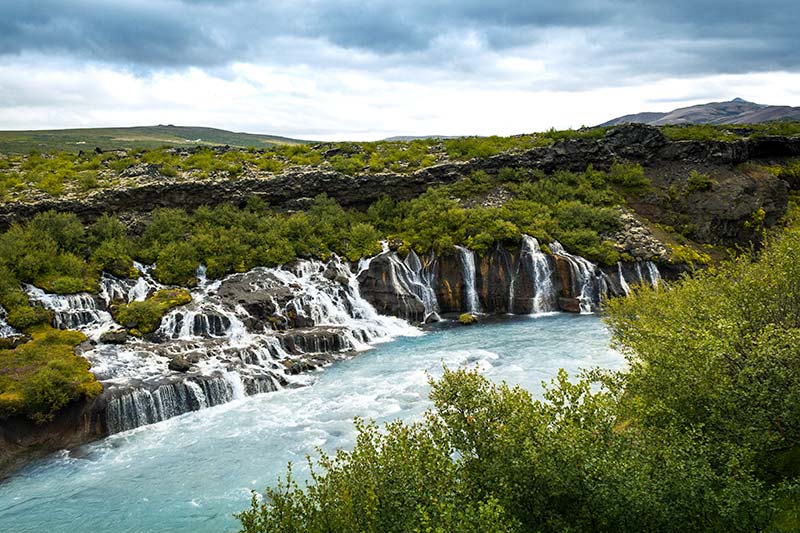
Your final stretch. But don’t let the word ‘final’ fool you. West Iceland has no intention of letting you coast to the finish line quietly. This leg of the journey packs in rolling farmlands, lava-tube caves, geothermal pools, sagas carved into stone, and waterfalls that burst out of lava fields like they just couldn’t hold it in any longer.
After a week of wilderness, it’s the perfect blend of comfort and character, where scenic drives meet sleepy towns and every pit stop comes with its own dose of Icelandic folklore.
The landscape softens here, but the storytelling gets richer, and you’ll find yourself looking for excuses to take the long way back to Reykjavík. You might be nearing the end, but Iceland isn’t done impressing you just yet.
Our Recommended Attractions & Activities
Take the scenic route via Skagafjörður, a region known for its horse farms and dramatic valleys. Stop in Borgarnes for a dip at the local geothermal swimming pool and maybe a visit to the Settlement Centre.
If you have time and fuel in the tank, a detour to the Hraunfossar and Barnafoss waterfalls is a nice final nature fix before you roll back into Reykjavík.
Recommended Local Campsites
If you are spending one more night before returning the van, Reykjavík Campsite is a convenient choice. Otherwise, check out smaller sites around Borgarfjörður or Hvalfjörður for a quieter goodbye.
If you’d rather be that much closer to the airport to make the next day that much easier, then spend the night at the Happy Campsite in Keflavík, where you’ll be greeted with open arms.
What Should You Prepare For?

Changing Icelandic Weather Conditions
Sunshine, wind, rain, snow – yes, all within the same hour, and sometimes while you’re trying to boil pasta outside your campervan. Icelandic weather isn’t just unpredictable; it’s downright cheeky. One moment you’re basking in sunshine and thinking maybe shorts were a good idea, and the next, you’re being pelted sideways with sleet that feels like nature’s version of a reality check.
This rapid mood-swinging climate is part of Iceland’s charm, but it does mean you need to come prepared. Dress in layers – lots of them. This should include thermals, a fleece, waterproofs, and always bring an extra pair of dry socks because, trust us, soggy toes are the enemy of joy.
Check the weather forecast daily, using reliable sources like the Icelandic Meteorological Office. And when the forecast says ‘mild winds,’ remember that ‘mild’ in Iceland might still blow your camper door shut with enough force to startle every sheep within a 5km radius. Adaptability is the name of the game here, and being ready for all seasons, every day, is the secret to a smooth Ring Road adventure.
Local Road Conditions
The entire Ring Road is paved and in excellent condition, making it one of the most accessible routes for campervan travel in Iceland. But that doesn’t mean you can switch to autopilot.
You’ll still encounter gravel sections at various pit-stops and attractions along the way, especially on side roads or in more remote regions, and a fair number of single-lane bridges, some of which are longer than you’d expect and require a polite game of chicken with oncoming traffic. Always yield to the car that arrived first and take it slow when visibility is limited.
Even in the summer months, weather can affect driving conditions dramatically, with wind gusts strong enough to rock your van or sudden rain turning dry roads slick. You can monitor road conditions across the whole country with real-time updates on road closures, weather warnings, and any tricky spots ahead.
Keep your headlights on at all times (it’s the law), and remember: driving in Iceland is less about speed and more about steady focus, common sense, and leaving enough space between you and the next waterfall stop.
Daylight Hours For Visiting Sites & Attractions
Summer in Iceland blesses you with what feels like eternal daylight. It provides up to 21 hours of daylight during the peak of June and July. This means you can easily explore late into the evening, take golden-hour photos at midnight, or start a hike after dinner just because you can.
But in winter, the script flips dramatically. In December, some parts of the country get only 4 to 5 hours of daylight, and the sun never climbs much higher than a sleepy yawn over the horizon.
If you’re travelling during shoulder seasons like April or October, daylight hours can vary quickly, so it’s important to keep tabs on sunrise and sunset times as you plan your activities. Prioritise your most scenic stops and longer hikes for the middle of the day, and try to do your driving while there’s still light.
In short, Iceland’s daylight dictates your rhythm, the trick is to learn to dance with it.
Local Campsites at Your Destinations
Use our map to scout campsites ahead of time and always have a backup option in mind, just in case.
What is the Best Time of Year For this Itinerary?
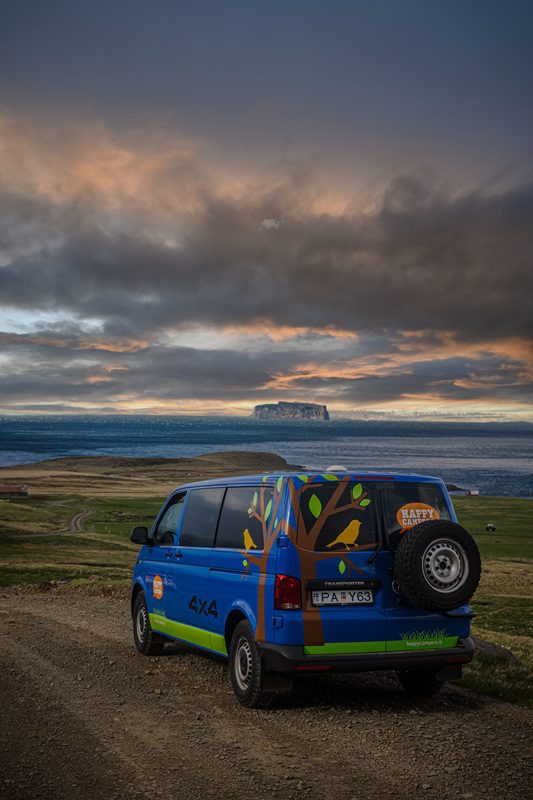
Late May through September is ideal for tackling the Ring Road in a campervan. During these months, Iceland is at its most accessible: roads are clear of snow and ice, all major attractions are open, and most campsites across the country are fully operational and lively.
The weather is as agreeable as it ever gets here, with relatively mild temperatures, longer daylight hours, and plenty of opportunities for golden hour adventures that stretch late into the evening.
June and July deliver the famous midnight sun, letting you pack more into each day without racing the sunset. August often brings lush landscapes and thriving birdlife, while waterfalls tend to be at their most powerful due to glacier melt.
The shoulder months (late May and early September) are perfect for those seeking fewer crowds and better prices on rentals and campsites, with the added bonus of still having decent daylight and road conditions. These months also give you a shot at seeing the Northern Lights without having to brave full-on winter travel.
If you’re after the sweet spot between access, weather, and that elusive Icelandic magic, aim for this window. Your vanlife adventure will thank you for it.
Research & Planning Tips
Download offline maps – Google Maps works well if saved in advance, and apps like Maps.me can be a helpful backup when signal drops off in remote areas. Alternatively, download our Iceland Travel eBook to get ahead of the game and leverage the local travel insights from across our team.
Follow local weather apps like Veður, Iceland’s official meteorological app, for real-time updates that will help you adjust your plans if a sudden snow squall or windstorm decides to crash your picnic.
Make sure your van is stocked with snacks, water, a thermos of something hot, and plenty of patience, especially for those moments when sheep crossings or one-lane bridges turn your ETA into a rough estimate that can even keep Mr Google on its toes.
And whatever you do, don’t overpack your itinerary. Iceland is best experienced slowly, with space to pull over for a surprise waterfall, soak longer in a hot spring, or follow a puffin you weren’t expecting to meet (not off a cliff, I might add). Leave room for wonder, which tends to show up when you’re not rushing.
What Should You Pack For a 7-Day Iceland Ring Road Trip?
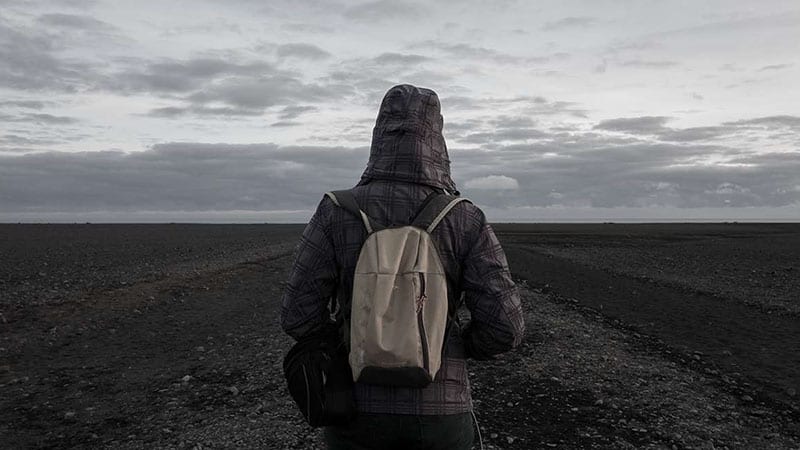
Layers of Clothing
Think thermals, T-shirts, fleece, rain jacket. Then add a few extras just in case.
Waterproof hiking boots are your best friend. No flip-flops unless you’re at a hot spring.
Appropriate Coats For Planned Activities
If you’re heading up a glacier, that cotton hoodie won’t cut it. Pack accordingly.
Camera Equipment
A decent camera, spare batteries, and a lens cloth. You’re going to need them.
Additional Camping Gear
While your Happy Camper comes equipped, you might want extras like headlamps, towels, or reusable water bottles.
What Type of Campervan Should I Rent?
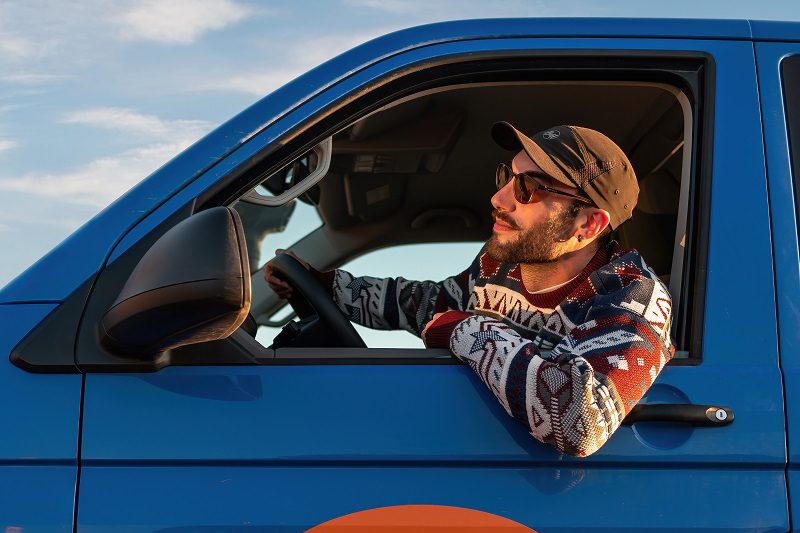
Solo travellers or couples can go minimal with a Happy 1, a compact and nimble camper that still includes everything you need for a proper Icelandic road trip. It’s ideal for those who want to keep things simple and focus on the journey rather than on managing gear.
If you’re travelling with a small group, kids, or just want a bit more breathing room and comfort, the Happy 4×4 XL offers a spacious upgrade with extra sleeping space, additional storage, and all-terrain capabilities to handle Iceland’s more rugged routes – including those elusive Highland roads.
All our vans come fully equipped with the essentials: comfortable beds with cosy bedding, a cooking area stocked with kitchenware, heating to keep things toasty even on chilly nights, and smart storage solutions to help keep the interior organised.
Optional add-ons like camping chairs, power inverters, and BBQ kits are available too, letting you tailor your van to match your travel style. Whether you’re on a romantic escape, a mates’ road trip, or a family adventure, there’s a Happy Camper setup that fits your vibe.
Conclusion
Iceland’s Ring Road isn’t just a drive. It’s a week-long story told in geysers, waterfalls, glaciers, and gas station hot dogs that are better than they have any right to be.
With your campervan as your rolling basecamp, you can chase the sun, dodge the crowds, and wake up each day somewhere unforgettable.
Plan smart, pack right, and remember to roll the windows down every now and then. There’s nothing quite like the soundtrack of the Icelandic wilderness.
See you on the road, and don’t forget to wave to fellow Happy Campers when you pass them by.
Back